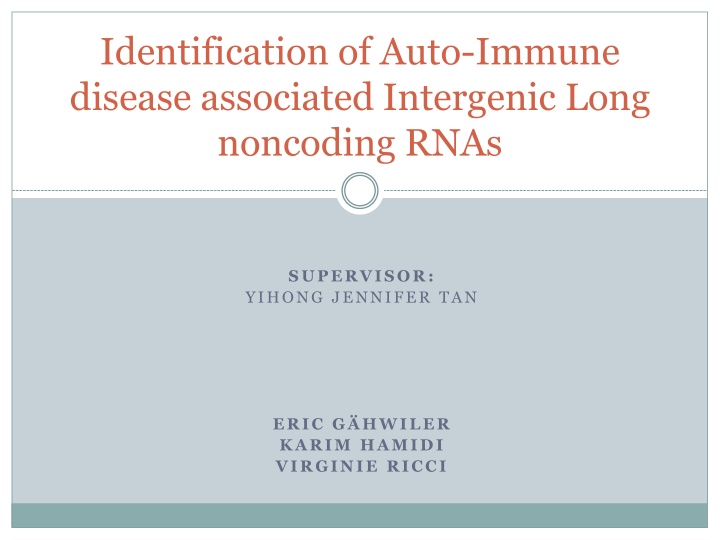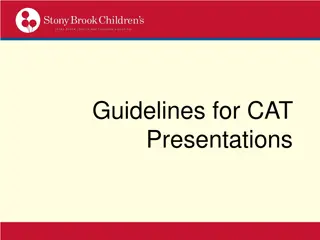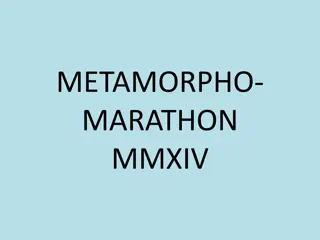
Auto-Immune Disease-Associated Intergenic Long Noncoding RNAs Study
Explore the identification and functions of intergenic long noncoding RNAs (lincRNAs) associated with auto-immune diseases. The project aims to understand the role of lincRNAs in human biology, disease traits, and genetic links to auto-immune conditions through correlation analyses.
Download Presentation

Please find below an Image/Link to download the presentation.
The content on the website is provided AS IS for your information and personal use only. It may not be sold, licensed, or shared on other websites without obtaining consent from the author. If you encounter any issues during the download, it is possible that the publisher has removed the file from their server.
You are allowed to download the files provided on this website for personal or commercial use, subject to the condition that they are used lawfully. All files are the property of their respective owners.
The content on the website is provided AS IS for your information and personal use only. It may not be sold, licensed, or shared on other websites without obtaining consent from the author.
E N D
Presentation Transcript
Identification of Auto-Immune disease associated Intergenic Long noncoding RNAs SUPERVISOR: YIHONG JENNIFER TAN ERIC G HWILER KARIM HAMIDI VIRGINIE RICCI
Plan Introduction - LincRNAs Identification Conservation and functions Project Interests Datasets Reminder of our last presentation New project goals Tools and Methods Data Manipulations Correlation Test Multiple Correction Test Results Conclusions Prospective Questions
LincRNA Identification Long Intergenic Non-coding RNAs > 200 base pairs Not coding for proteins No apparent open reading frame Similarities with mRNAs: Cap, polyA tails, splice junction Transcribed by Pol II Differences from mRNAs: More lowly expressed More tissues-specific Many are found in the nucleus, although some are found in the cytoplasm
lincRNA conservation and functions Some lincRNAs are conserved in species Examples of lincRNA functions:
Project interests Human genome completely sequenced in 2003 Use genome sequencing data to understand human biology Identify links between lincRNAs and various human phenotypes lincRNAs and disease traits
Dataset LincRNAs & Genotype LCL (lymphoblastoid cells line) of 373 European individuals from the Geuvadis dataset Expression levels of lincRNAs (Gencode) RNA sequencing measured in RPKM Genotypes of the individuals SNP sequencing e.x. C/C, C/T, T/T
Reminder Establish a correlation between the expression of lincRNAs and genetic variants recently linked to obesity and BMI cis-eQTL analysis Wrong tissues used to study BMI traits
News Goals New goals Determine whether long intergenic noncoding RNAs play a functional role in Auto-Immune traits and diseases Establish a correlation between the lincRNA expression level and genetic variant associated to immune traits - cis-eQTL analysis
Dataset - SNPs Auto-Immune traits associated SNPs NIH:
Dataset Crohn's disease Hypothyroidism Multiple sclerosis Psoriatic arthritis Rheumatoid arthritis Systemic lupus erythematosus and Systemic sclerosis Type 1 diabetes Only SNPs associated to the traits with a p.value < 5x10-8 579 SNPs associated to immune traits
Methodology Data collecting and manipulations Estimate correlation test between lincRNAs expression levels and genotypes of Auto-Immune diseases-SNPs cis-eQTL Randomized multiple correlation test
Methodology + LincRNAs location (7256) SNPs location (579) lincRNA close to the SNPs (2409 pairs) lincRNAs expression level (467) Genotypes of the SNPs (402) Pearsons Correlation Test Multiple test correction
Multiple Correlation Tests Multiple Test : Many genotype ~ many expressions levels 373 / gene Corresponding to do a correlation test for each expression levels and genotypes Multiple Test problem : For each individual correlation test error = 0.05 False Discovery Rate or FDR
Multiple Test correction 1) For each lincRNA :SNP pair: Randomize 373 lincRNA expression 1000 times Evaluate 1000 correlation tests with permuted data Store the maximum permuted correlation value 2) Obtain 95% quantile of the permuted correlation value (5%FDR) 3) Compare observed correlations with 5%FDR, and accept observed correlation values as significant only if it passes 5%FDR test.
Results Gene name: ENSG00000224950 Chromosome 1 SNP name: rs2300747 Correlation coefficient: 0.210 Associated disease : Multiple sclerosis Corrected p.value: 0.079
Results Gene name: ENSG00000224950 Chromosome 1 SNP name: rs1335532 Correlation coefficient: 0.210 Associated disease : Multiple sclerosis Corrected p.value: 0.079
Visualization lincRNA (ENSG00000224950) rs1335532 rs2300747 http://www.carefecthomecareservices.com/blog/multiple-sclerosis-definition-causes-types-symptoms/
Results Gene name: ENSG00000258701 Chromosome 14 SNP name: rs2841277 Correlation coefficient: -0.220 Associated disease : Rheumatoid arthritis Corrected p.value: 0.055
Visualization lincRNA (ENSG00000258701) Visualisation tool Rheumatoid arthritis rs2841277 http://fr.wikipedia.org/wiki/Polyarthrite_rhumato%C3%AFde#/media/File:Rheumatoid_Arthritis.JPG
Conclusions No correlation at FDR < 5% Found 2 LincRNAs whose expression levels is correlated with SNPs associated with Multiple sclerosis & Rheumatoid arthritis FDR < 10%
Prospects Using other datasets, see if can reproduce the same results Possibly in same or different tissues (i.e. neuronal tissues, skin etc.) Further analyze the characteristics and functions of the lincRNAs Whether there is an implication of the lincRNA in respective diseases Multiple Sclerosis Rheumatoid arthritis
Feedback Difficulties Keep a global vision of the project Data manipulations Find an error in many code line Learnings LincRNAs R programmation Methodologyies in a study
Questions? THANK YOU FOR YOUR ATTENTION





